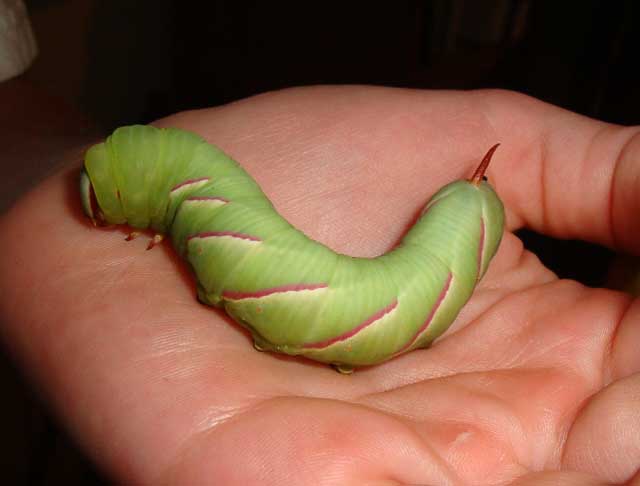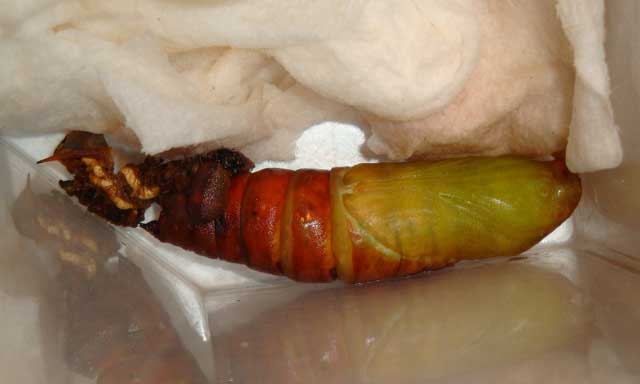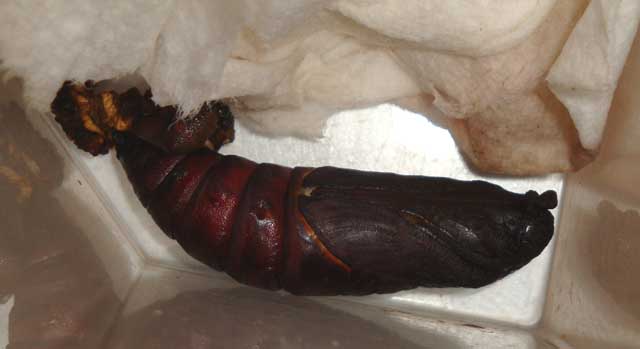Spokane County, Washington
Sphingidae Larvae
Sphinx drupiferarum Spokane County, Washington,
early September, courtesy of Cindy, Mark, Evan and Graham Brower.
|
|
Updated as per James P. Tuttle's The Hawk Moths of North America, September 20, 2008 |

Sphinx drupiferarum Spokane County, Washington,
early September, courtesy of Cindy, Mark, Evan and Graham Brower.
They write, "We live in Spokane, WA (on the border with Idaho) and two weeks ago we found a Wild Cherry Sphinx Caterpillar in our yard. We’ve never seen one like it in this area and were wondering if it’s native to this area. Also, we followed your instructions and placed wet paper towels in its habitat and, after thinking he was dead for a few days, he pupated which was wonderful to see! Now we are wondering how long til eclosion and is there anything we should do to prepare for this?
"Thank you for setting up your very informative website – yours is the only one I could find that correctly identified our Wild Cherry Sphinx! It’s been fascinating!
"P.S. We named him Nigel."
I replied, "Congratulations.
"The moth wil not eclose until spring. To prevent an indoor mid winter eclosion due to warm house temps, you should put the pupa, wrapped, like a cigar, in a single piece of toilet tissue. Store it in sandwich sized or smaller ziploc/gladware/tupperware plastic container lid on tight, no airholes in fridge crisper. Take it out in early May. Please read http://www3.islandtelecom.com/~oehlkew/zpupae.htm and http://www.silkmoths.bizland.com/emerge.htm.
"Hard to tell for sure whether you have Sphinx drupiferarum or Sphinx perelegans. The larvae are very similar. Can you send another image (first image sent did not show horn) of Nigel showing the anal horn or can you remember if it was blue (perelegans) or reddish (drupiferarum)?
"I would like permission to use image, with credit to you, on webpage I will create for Spokane County Sphingidae larvae."
"Thank you so much for your prompt and helpful response! We will follow your instructions. Here is another picture of Nigel where you can see his red
horn.
"Yes, you have our permission to use our images on your webpage – our boys, 5 & 7 years old, are very excited about this, as are we."
For care of "found larvae/caterpillars" visit Manduca sexta larva, Travis County, central Texas, August 21, 2008, Trina Woodall.
Only seventeen Sphingidae species are listed for Washington on the U.S.G.S. website. Not all of the species are reported or anticipated in Spokane County (Eight are reported on U.S.G.S. as of September 20, 2008). It is hoped that this checklist, with the thumbnails and notes, will help you quickly identify the larvae you are likely to encounter. A "WO" after the species name indicates that I have no confirmed reports of this species in your county, but I (William Oehlke) expect that this moth with its larvae are present or might be present. I have included many species not on the USGS list for Washington; I believe they are or might be present
A "USGS" indicates the moth is reported in Lepidoptera of North America, #1. Distribution of Silkmoths (Saturniidae) and Hawkmoths (Sphingidae) of Eastern North America, an excellent little booklet available through Paul Opler.
Please help me develop this list with improved, documented accuracy by sending sightings (species, date, location), preferably with an electronic image, via email to Bill Oehlke.
Many thanks to Zana Goulding who provides the following beautiful images of another Sphinx drupiferarum larva from Spokane. Note the yellowish "leggings" on the abdominal feet and the absence of black spots at the apex of the head. In a very similar species, Sphinx perelegans, the leggings are a purplish-lilac, and there are two black spots, often hidden by a thoracic shield, at the apex of the head.

Sphinx drupiferarum fifth instar, Spokane, Spokane County, Washington,
September 5, 2012, courtesy of Zana Goulding.

Sphinx drupiferarum fifth instar, Spokane, Spokane County, Washington,
September 5, 2012, courtesy of Zana Goulding.
Sphinginae subfamily
Sphinx drupiferarum larva, September 5, 2012, Spokane, Zana Goulding
Smerinthini Tribe:
Macroglossinae subfamilyDilophonotini tribe:
Macroglossini tribe:
|

Sphinx drupiferarum fresh pupa, Spokane County, Washington,
early September, courtesy of Cindy, Mark, Evan and Graham Brower.

Sphinx drupiferarum hardened pupa, Spokane County, Washington,
early September, courtesy of Cindy, Mark, Evan and Graham Brower.
This page is brought to you by Bill Oehlke and the WLSS. Pages are on space rented from Bizland. If you would like to become a "Patron of the Sphingidae Site", contact Bill.
Please send sightings/images to Bill. I will do my best to respond to requests for identification help.
 Show appreciation for this site by clicking on flashing butterfly to the left. The link will take you to a page with links to many insect sites. |